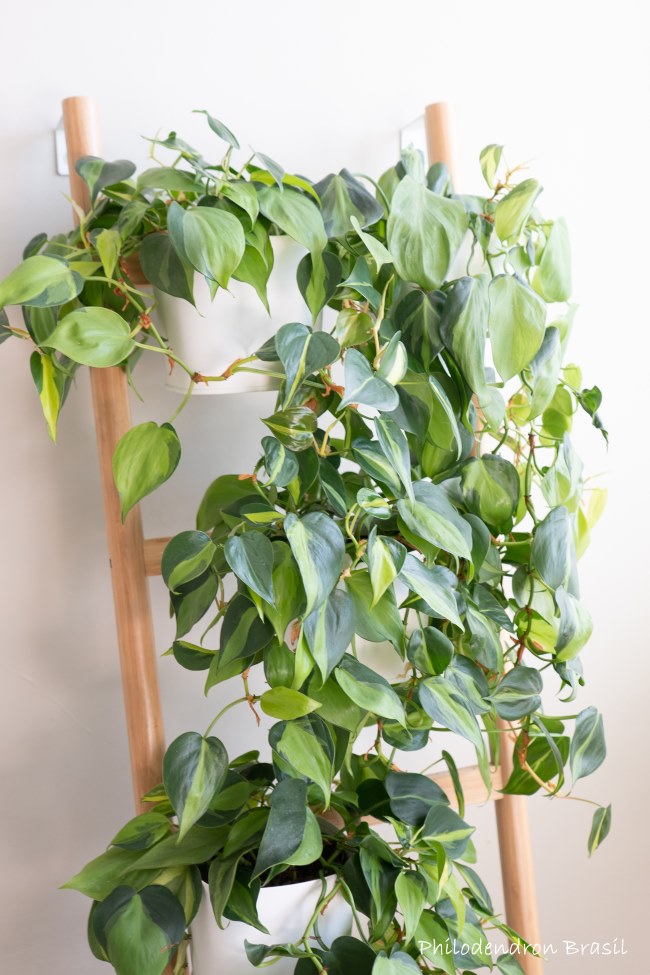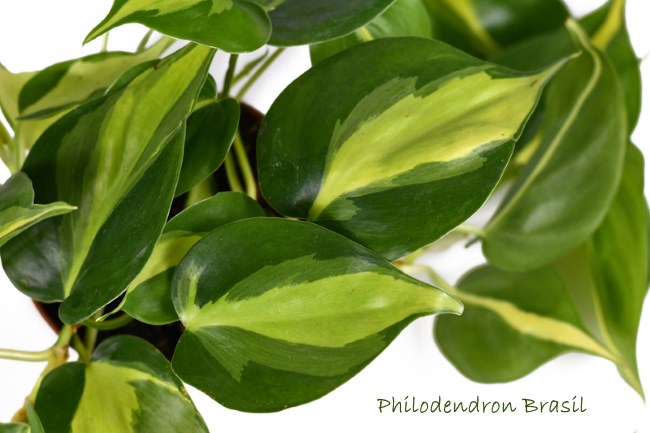Philodendron Brasil
Botanical Name: Philodendron hederaceum 'Brasil'
Philodendron Brasil is one of the most exciting new cultivars to come along.
Part of a new generation of splashed, streaked and spotted houseplants, 'Brasil' has just stepped into the limelight, offering captivating style to an indoor garden. It looks spectacular on its own, too.
 Show off Philodendron Brasil by allowing the long stems to trail. Photo ©Ida Taing
Show off Philodendron Brasil by allowing the long stems to trail. Photo ©Ida TaingGet to Know Philodendron Brasil
Philodendrons have been cultivated indoors for generations. And for good reason. They're dependable houseplants -- shrugging off neglect now and then, and quickly responding when given proper care.
Philodendron hederaceum 'Brasil' is a cultivar closely related to my long-time favorite Heartleaf Philodendron (P. scandens) and is just as easy to please, enjoying the same warm temperatures, moderate humidity and indirect sunlight.
Philodendron Brasil not only takes its place in this family of easy-care plants, but also boasts long tropical vines of lime-green splashed foliage to brighten up any room.
Whether you train this twining vine to climb, or allow it to trail, you'll love growing this variegated plant. Brasil seems custom-made to lend fresh life to the clean lines and neutral colors of today's homes.
Pinch and Prune
Want a fuller plant? Pinch off growing tips to make your Philodendron Brasil branch out. Use your fingernails or scissors to cut the stem after a leaf node (the place where a or leaf is attached to the stem). Cuts made here will cause the stem to branch, giving your houseplant a lush, full look.
Prune it back anytime to keep it under control. Left to grow, stems will reach several feet long.
Philodendron Hederaceum Varieties
Want more gorgeous varieties of this easy-care Philodendron? I thought so.
New cultivars and hybrids offer captivating colors and patterns to satisfy any plant collector's penchant for the hottest trend in houseplants.
Rio, Silver Stripe, and Cream Splash are just a few. Take a look at Gabriella Plants for pictures and descriptions of variegated Philodendron hederaceum. It's a reputable resource for identifying this new wave of multi-color varieties.
Philodendron Brasil Problems, Solutions and Answers
Brown leaf tips are common on tropical plants suffering in the dry air of a heated home. See "Humidity" tips below.
Leggy stems, having several inches between leaves are caused by a lack of sunlight. Give your houseplant plenty of bright, indirect light to maintain its full, leafy appearance. Don't be afraid to cut off bare stems; this vigorous grower will quickly replace them.
Small leaves may be a sign of low light levels or lack of fertilizer.
Philodendron Brasil reverting to all green? It's not getting enough sunlight. Move this variegated plant closer to a window, but protect it from hot, direct sunlight, which can cause brown scorch marks on its leaves. Give them time, leaves may develop variegation as they age. If not, you can cut them off, if you want.
Is Philodendron Brasil poisonous? Yes, Philodendron leaves are toxic to people and pets, though a lot of leaves would have to be eaten to cause serious illness. Some people are allergic to the sap, which can cause an itchy rash in some people. If you're sensitive to Philodendron sap, wear gloves when handling this plant.
Something bugging your plant? Watch for fungus gnats that hop or crawl on the surface of the soil. They're attracted to wet, peat-based potting mixes. Also look for aphids under leaves and along stems. They suck plant juices, leaving new leaves that look wrinkled with yellow specks. Treat any infestation immediately to prevent bugs from invading your other houseplants.
 Vibrantly patterned foliage make Brasil houseplant a knockout. Photo © Monikabaumbach
Vibrantly patterned foliage make Brasil houseplant a knockout. Photo © MonikabaumbachWondering when to repot? If the roots are growing out of the drainage holes, or the crown of the plant is pushing above the soil, your houseplant needs repotted. Fresh, loose potting mix will rejuvenate a plant. Spring is the best time, when plants begin their most vigorous time of growth. Use a pot 1- to 2-inches larger. Don't over-pot -- a common mistake with houseplants. Why? A pot that's too big will hold too much water and may lead to root rot.
Philodendron Brasil Care
Origin: South America
Height: Climbs or trails to 4 ft (1.2 m) or more.
Light: Moderate to bright light. Small leaves or long spaces between leaves show that the plant is not getting enough light. Move your philodendron plant to a brighter location, but not into direct sun which can scorch its leaves. Don't have a sunny spot? Philodendron Brasil thrives under artificial grow lights.
Water: Water Philodendron Brasil thoroughly, then allow the top 1-inch (2.5 cm) of soil to dry out before watering again. Always use tepid water for your houseplants because cold water is a shock to these tropical natives. Yellow leaves are caused by over-watering.
Humidity: Aim to maintain 45% relative humidity or higher. Indoor air can become extremely dry in winter without our noticing it. It's a good idea to use a humidity monitor near your tropical plants, rather than guess. Use a humidity tray or a cool-mist room humidifier to raise the humidity for your tropical houseplants and they'll feel right at home. Brown leaf tips are a symptom of dry air.
Temperature: Average room (65-80°F/18-27°C). Keep this South American native warm year-round. It will tolerate a minimum of 60°F/16°C. Don't expose your houseplants to cold blasts from an entryway or set them near a heat/AC vent.
Soil: Peat moss-based mix with added perlite for fast drainage. African violet potting mix is ideal.
Fertilizer: Feed once a month spring through fall with a balanced water-soluble fertilizer, diluted by half. Stop fertilizing in winter, when growth is slow.
Propagation: Take 3-4 in/7-10 cm-long stem tip cuttings (each with at least 3 leaves attached) in spring or early summer. Cut just below a leaf node (the place where the leaf is attached to the stem). Nodes contain cells that will develop new roots. Philodendron Brasil roots easily in water or lightly moist soil.


